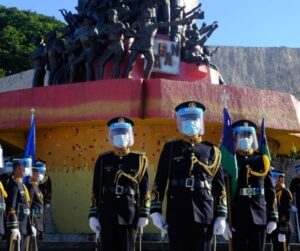China made its displeasure known when Taiwan President Tsai Ing-wen met with Speaker of the House Kevin McCarthy (R-CA) on April 5 by performing a People’s Liberation Army Navy (PLAN) live-fire drill close to Taiwan. In a similar flex of muscle, from April 11 to 28, the United States, Australia, and the Philippines will execute a combined forces military exercise called Balikatan 23, the largest of its kind, to improve the ability of US and Philippine forces to work together seamlessly. The word Balikatan means “shoulder-to-shoulder” in Tagalog.
Often confused in press accounts is the difference between “joint” and “combined” exercises. As a US Army publication explained, “A joint exercise involves forces of more than one Service. A combined (often called multinational or multilateral) exercise involves forces of more than one nation.” The Indo-Pacific Command, the US sponsor of the training, announced the beginning of the exercise with a Tweet, explaining, “US Armed Forces and Armed Forces of the Philippines are preparing to commence the largest iteration of Exercise Balikatan 23, with over 17,000 participating troops.”
Armed Forces of the Philippines Joins With US Military
In addition to combat arms training, the 38th iteration of the annual combined exercise will include 12,200 US military, 5,400 members of the Armed Forces of the Philippines (AFP), and 111 Australians. In logistics support for the training, a C-17 from the 62nd Airlift Wing is shown in a video offloading a US Navy medium-sized combatant watercraft. The US and AFP militaries developed exercise scenarios to maximize training in tactics, techniques, and procedures to improve “capability in the areas of maritime security, amphibious operations, live-fire training, urban and aviation operations, cyber defense, counterterrorism, and humanitarian assistance and disaster relief preparedness,” according to the US Indo-Pacific Command’s press release.
The significance of the exercise should not be underestimated. The recent Enhanced Defense Cooperation Agreement (EDCA) between the governments of the United States and the Philippines allows US forces on a rotational basis access to and use of nine military camps and bases. As Secretary of Defense Lloyd Austin III told the Pentagon press corps at a joint briefing with his Philippine counterpart, Secretary of National Defense Carlito Galvez, in February:
“It’s a big deal. And so, it’s a key pillar of our training and opportunities to strengthen our interoperability. And it also provides us the ability to respond effectively to humanitarian issues and also disaster relief and other types of crises, not just for the Philippines but for the region throughout. This is part of our effort to modernize our alliance, and these efforts are especially important as the People’s Republic of China continues to advance its illegitimate claims in the West Philippine Sea.”

(Photo by: Aileen Dimatatac/Majority World/Universal Images Group via Getty Images)
Balikatan 23 is part of the Joint Chiefs of Staff global exercise program. Combined military exercises have for decades allowed the US military to provide valuable training to allies and send diplomatic messages to regional enemies. For example, during the Cold War, the Soviet Union was put on notice every other year that the United States could redeploy quickly to Germany to stop the USSR from invading. US forces made that point with a field training exercise called Return of Forces to Germany (REFORGER), which involved NATO forces and US joint military operations. In 1988, America sent to Europe 125,000 ground troops. The exercise made a statement to friend and foe alike.
US Indo-Pacific Command Point-of-the-Spear Facing China
Led by the Indo-Pacific Command, the United States is making its presence known throughout the South China Sea and western Pacific region, where Beijing has employed an area denial strategy. The EDCA, the outreach to the Pacific Island nations, and freedom of navigation (FON) operations have responded to Beijing’s bad behavior of late. Most recently, “A US Navy destroyer sailed near one of the most important man-made and Chinese controlled islands in the South China Sea on Monday (April 10), in a freedom of navigation mission that Beijing denounced as illegal,” Reuters reported. It was a direct response to the PLAN’s live fire and hostile drills in the waters close to Taiwan. With the newly inked EDCA, the United States and the Philippines can re-energize the close partnership enjoyed for many years following World War II. With the Chinese Communist threat coming to a boil, the timing could not be better.
The views expressed are those of the author and not of any other affiliation.
All opinions expressed are those of the author and do not necessarily represent those of Liberty Nation.
Do you have an opinion about this article? We’d love to hear it! If you send your comments to [email protected], we might even publish your edited remarks in our new feature, LN Readers Speak Out. Remember to include the title of the article along with your name, city, and state.
Please respect our republishing guidelines. Republication permission does not equal site endorsement. Click here.

